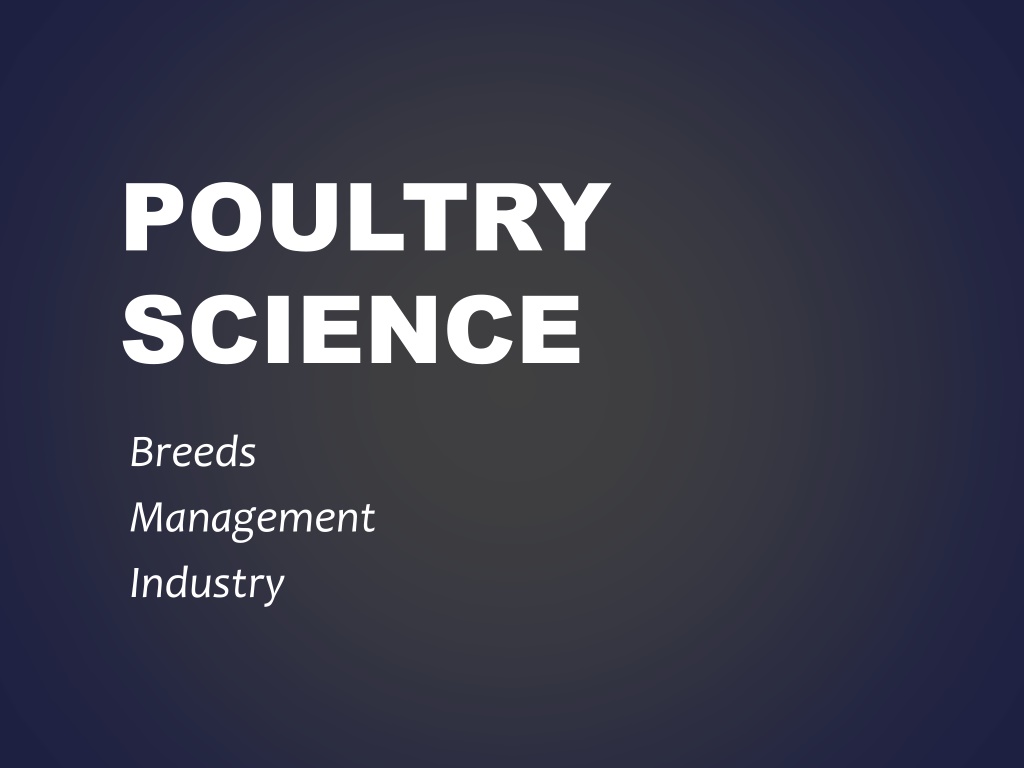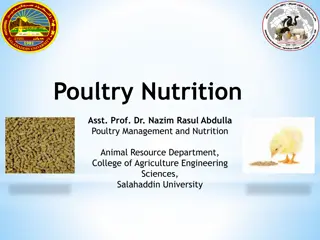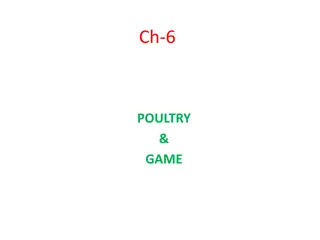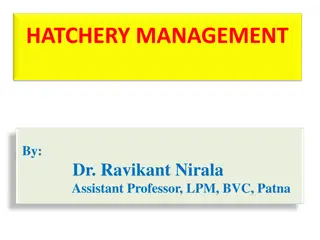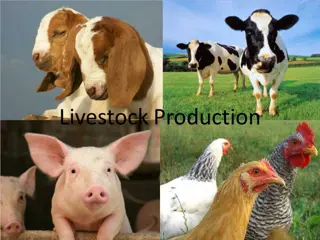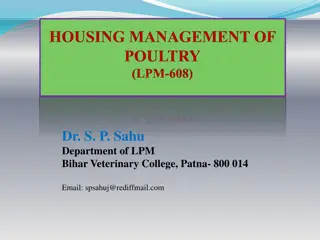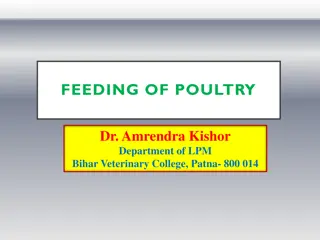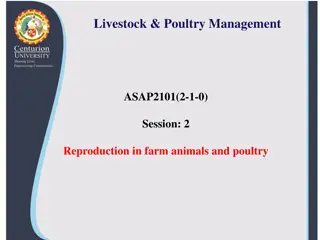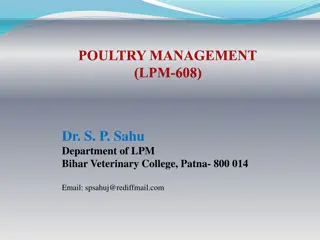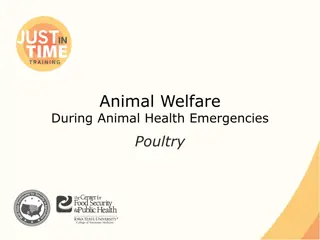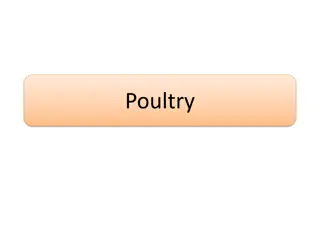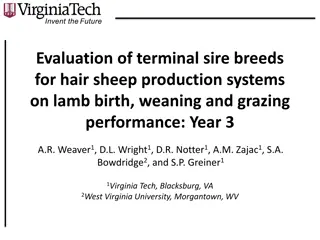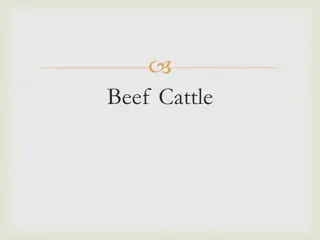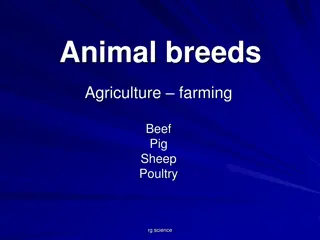Essential Guide to Poultry Breeds and Management
Explore the world of poultry science covering breeds, management, and industry practices. Learn about different classes of chicken breeds, meat-producing chicken and turkey breeds, egg production breeds, and how to determine egg color based on characteristics. Gain insights into the primary species used in the US poultry industry and key features of various poultry breeds.
Download Presentation

Please find below an Image/Link to download the presentation.
The content on the website is provided AS IS for your information and personal use only. It may not be sold, licensed, or shared on other websites without obtaining consent from the author. Download presentation by click this link. If you encounter any issues during the download, it is possible that the publisher has removed the file from their server.
E N D
Presentation Transcript
POULTRY SCIENCE Breeds Management Industry
WHAT IS POULTRY? Domesticated fowl raised for meat and/or eggs Primary species used in US Poultry industry: Chickens (meat and eggs) Turkeys (meat) Other species include: Ducks Geese Quail Phesant Emus Ostriches
POULTRY SCIENCE Breeds Management Industry
CLASSES OF CHICKEN BREEDS American Clean legged; no feathers on shanks Yellow legs and beaks Red earlobes Lay brown eggs Mediterranean Smaller bodied birds Clean legged White earlobes Lay white eggs Asiatic Large bodies Feathered shanks; feathers on legs Red earlobes Lay brown eggs English White skin (Cornish has yellow) Red ear lobes Lay brown eggs
MEAT PRODUCING CHICKEN BREEDS Cornish Cross Chicken Cross breed of chicken (White Cornish and commonly White Plymouth Rock ) White feathers Heavy musculature and broad breasted These birds are called Broilers
MEAT PRODUCING TURKEY BREEDS Broad Breasted White Turkey Originated as a cross breed (White Holland & Broad Breasted Bronze) White feathers Most commonly used in commercial operations Very emphasized muscularity and growth rate Large breast prevents natural reproduction; must be artificially inseminated.
MEAT PRODUCING TURKEY BREEDS Broad Breasted Bronze Bourbon Red White Holland Slate Narragansett Black
EGG PRODUCTION BREEDS Female chickens called LAYERS Hens only lay eggs during their laying cycle Typically begin to lay around 4-6 months of age
How can you tell what color eggs a chicken may produce? Feather color A white lobed hen Feet color will lay white eggs, while a red lobed Earlobe color hen will lay brown eggs .
BREEDS IN EGG PRODUCTION Leghorn (Mediterranean) Most abundant egg laying breed White feathered, small hens (smaller than broilers) Lays large white eggs Used in commercial egg production
BREEDS IN EGG PRODUCTION White Plymouth Rock (American) White feathered, large hens Lays brown eggs Not as efficient as Leghorn
DUAL PURPOSE BREEDS Used for both meat and eggs New Hampshire (American) Red feathered Heavy bodied hens Lays large brown egg Not quite as efficient in meat or egg production as other breeds
DUAL PURPOSE BREEDS Wyandotte (American) Round Bodied birds Come in several different varieties : White, Buff, Silver- Laced, Colombian, Black Lay brown eggs Not quite as efficient in meat or egg production as other breeds
DUAL PURPOSE BREEDS Rhode Island Red (American) Long Rectangular body Deep red feathers Lay brown eggs Not quite as efficient in meat or egg production as other breeds
DUAL PURPOSE BREEDS Barred Plymouth Rock (American) Barred refers to the variety of Plymouth Rock. (notice the barred feathers) Feathers have sharply defined dark lines Large bodied birds Lays brown eggs Not quite as efficient in meat or egg production as other breeds
DUAL PURPOSE BREEDS Cochin (Asiatic) Massive appearance with breast carried low Long feathering and abundantly feathered shanks Come in several different varieties (Buff, Partridge, White, Black) Lays brown eggs Not quite as efficient in meat or egg production as other breeds
POULTRY SCIENCE Breeds Management Industry
GENERAL POULTRY MANAGEMENT 1. Housing 2. Feeding/ Watering 3. Maintenance
HOUSING Size of coop should correlate with the size of flock As flock numbers increase coop size should increase HOUSING DESIGN SHOULD: Accommodate for birds purpose Provide shelter and adequate ventilation Protect poultry from predators Keep litter dry and safe from weather
HOUSING CONTINUED BASIC EQUIPMENT NEEDED: Water and feeders Litter (wood shavings or hay) Appropriate lighting Brooder (when needed)
TYPES OF HOUSING Brooder: young birds Grower house: meat producers kept at a consistent 90 -91 F temp. in first few week(s) of life. Layer house: laying hens Contains nest boxes for layers Contains abundant feed and water
FEEDING/ WATERING Poultry receive diets with different levels protein and energy All poultry should be fed ad libitum: having feed available at all times GROWER BIRDS LAYER HENS Excess protein causes rapid development and hens laying too early Layer feed: 16% protein +Calcium (to produce egg shells) Different feeds provide different levels of protein Starter feed: 22-24% protein Grower feed: 15-18% protein Finisher feed: 16% protein
FEEDING/ WATERING Mash- ingredients mixed together but each ingredient remains separate; best for layers Crumbles- chopped up pellets; best for young meat birds Pellets- ingredients finely ground then mixed and compressed into larger pellets; best for mature meat birds
FEEDING/ WATERING Growth rate of meat birds is directly related to clean water intake Clean water should be available ad libitum Sanitizing containers cuts down on bacteria
MAINTENANCE Lighting Programs: LAYERS Approximately 14 hrs of light per day required to stimulate a hen to lay Artificial lighting in winter (short- days) meet a laying hen s photoperiod requirementfor laying GROWERS Heat lamps maintain a warm environment for young birds Heat lamps are raised to lower temperature Timed lights used to stimulate activity for idle birds
MAINTENANCE Ventilation/ humidity Fans and windows reduce humidity and temperature Dry living environment promotes good health and reduces ammonia levels Ammonia causes blisters Human interaction Important to interact with birds; feed and water, collect eggs, check on birds, clean pen interior and litter
MAINTENANCE Culling: selecting the best birds by reducing the population of undesirable birds Small, sick, stunted or deformed birds should be removed when detected Remove smaller and poorer fleshed birds at 4 wks of age Uniformity of birds and body quality improves with the increase in floor and feeder space
POULTRY SCIENCE Breeds Management Industry
INDUSTRY INDUSTRY Vertical integration: all aspects of the industry are owned by the same company For example: Tyson or Sanderson Farms will own its own feed mill, hatchery, and processing plants, trucking fleet, veterinarians...etc. No middle man; reduces costs of paying a third party Did you know: over 90% of poultry raised for human consumption in the US are produced by independent farmers working under contract with integrated companies
EGG PRODUCTION Caged Egg production: Hens kept in cages with sloped floors allowing eggs to roll to the front of the cage for collection Waste products continually and automatically removed to maintain a clean living environment
EGG PRODUCTION Over 6 billion eggs produced commercially each month in US Each hen lays ~250 eggs per year Iowa and Ohio produce the most commercial eggs
MEAT PRODUCTION Virtually all commercial meat birds are white feathered Raised in environmentally controlled houses with ad libitum access to feed and water to promote growth Broilers are raised to ~ 4.25 7 lbs Turkeys are raised to ~ 18 45 lbs 10% sold as whole carcass 90% are further processed (lunch meat, pizza toppings..)
SOME THINGS TO THINK ABOUT Why do most commercial meat birds have white feathers? Why would it be important to vertically integrate the industry? Why would the industry mix breeds?
